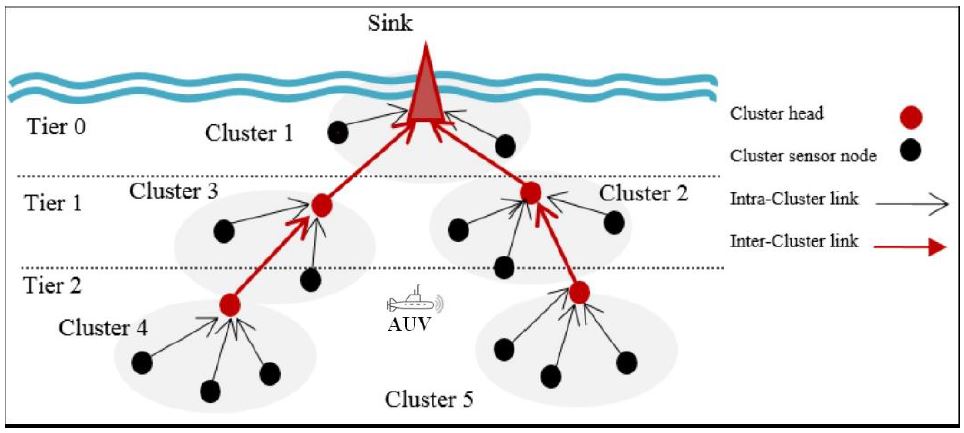FAULT-TOLERANT BACKUP CLUSTERING ALGORITHM FOR SMART CONNECTED UNDERWATER SENSOR NETWORKS
DOI:
https://doi.org/10.15282/ijsecs.8.1.2022.4.0094Keywords:
Topology-Aware, Network Hierarchy, Fault-Tolerance, Backup Algorithm, Multi-Parameter Model, Cluster FormationAbstract
This paper addresses poor cluster formation and frequent Cluster Head (CH) failure issues of underwater sensor networks by proposing an energy-efficient hierarchical topology-aware clustering routing (EEHTAC) protocol. In this paper, fault-tolerant backup clustering (FTBC) algorithms and multi-parameter cluster formation (MPCF) model were developed for the EEHTAC operation. The MPCF model tackles the issue of poor cluster formation performance by integrating multiple parameters to achieve effective clustering process. The FTBC algorithms tackle the issue of frequent CH failures to avoid interruption in data transmission. Performance of the MPCF model was evaluated using normal, high-fault, and high routing overhead network scenarios. Performance metrics employed for this analysis are temporal topology variation ratio (TTVR), CH load distribution (CLD), and cluster stability (STB). Obtained results show that operating with a CH retention period of 90s achieves better CH duty cycling per round and improves the MPCF process with values of 25.69%, 55.56%, and 60% for TTVR, CLD, and STB respectively. Performance of the FTBC-based EEHTAC was evaluated relative to Energy-balanced Unequal Layering Clustering (EULC) protocol. Performance indicators adopted for this evaluation are routing overhead (Ω), end to end delay (Δ), CH failures recovered (CFR), CH failures detected (CFD), received packets (θ), and energy consumption (Σ). With reference to the best obtained values, EEHTAC demonstrated performance improvement of 58.40%, 29.94%, 81.33%, 28.02%, 86.65%, and 54.35% over EULC variants in terms of Ω, Δ, CFR, CFD, θ, and Σ respectively. Obtained results displayed that the MPCF model is efficient for cluster formation performance and the FTBC-based EEHTAC protocol can perform effectively well against an existing CBR protocol.
References
I. F. Akyildiz, D. Pompili, and T. Melodia, "Underwater acoustic sensor networks: research challenges." Ad hoc networks 3,
no. 3, pp. 257-279, 2005. DOI: 10.1016/j.adhoc.2005.01.004
K. M. Awan, P. A. Shah, K. Iqbal, S. Gillani, W. Ahmad, and Y. Nam, "Underwater wireless sensor networks: A review of
recent issues and challenges." Wireless Communications and Mobile Computing 2019 (2019). DOI:10.1155/2019/6470359
N. Saeed, M. S. Alouini, and T. Y. Al-Naffouri, "To boldly go where no sensor has gone before: The movement to place IoT
in radical new spaces." arXiv preprint arXiv:1903.11996, 2019.
J. Heidemann, M. Stojanovic, and M. Zorzi, "Underwater sensor networks: applications, advances and challenges."
Philosophical Transactions of the Royal Society A: Mathematical, Physical and Engineering Sciences 370, no. 1958 pp. 158-
, 2012. DOI: 10.1098/rsta.2011.0214
E. C. Liou, C. C. Kao, C. H. Chang, Y. S. Lin, and C. J. Huang, "Internet of underwater things: Challenges and routing
protocols." In 2018 IEEE International Conference on Applied System Invention (ICASI), pp. 1171-1174, 2018.
DOI:10.1109/ICASI.2018.8394494
C. C. Kao, Y. S. Lin, G. D. Wu, and C. J. Huang, "A comprehensive study on the internet of underwater things: applications,
challenges, and channel models." Sensors 17, no. 7, 1477, 2017. DOI: https://doi.org/10.3390/s17071477
A. F. Salami, E. A. Adedokun, F. Al-Turjman, H. Bello-Salau, B. O. Sadiq, and E. M. Dogo, "Explorative analysis of AUVaided cluster-based routing protocols for Internet of intelligent underwater sensors." In Drones in Smart-Cities, pp. 143-187,
Elsevier. DOI: http://dx.doi.org/10.1016/B978-0-12-819972-5.00009-4
M. C. Domingo and R. Prior, "Energy analysis of routing protocols for underwater wireless sensor networks." Computer
communications 31, no. 6, pp. 1227-1238, 2008. DOI: https://doi.org/10.1016/j.comcom.2007.11.005
R. Hou, L. He, S. Hu, and J. Luo, "Energy-balanced unequal layering clustering in underwater acoustic sensor networks."
IEEE Access 6, pp. 39685-39691, 2018. DOI: https://doi.org/10.1109/ACCESS.2018.2854276
M. Ahmed, M. Salleh, and M. I. Channa, "CBE2R: clustered-based energy efficient routing protocol for underwater wireless
sensor network." International Journal of Electronics 105, no. 11, pp. 1916-1930, 2018. DOI:
https://doi.org/10.1080/00207217.2018.1494323
F. Zhu and J. Wei, "An energy efficient routing protocol based on layers and unequal clusters in underwater wireless sensor
networks." Journal of Sensors, 2018. DOI: https://doi.org/10.1155/2018/5835730
Z. Wan, S. Liu, W. Ni, and Z. Xu, "An energy-efficient multi-level adaptive clustering routing algorithm for underwater
wireless sensor networks." Cluster Computing 22, no. 6, pp. 14651-14660, 2019. DOI: https://doi.org/10.1007/s10586-018-
-8
A. F. Salami, E. M. Dogo, T. Makaba, E. A. Adedokun, M. B. Muazu, B. O. Sadiq, and A. T. Salawudeen, "A Decade
Bibliometric Analysis of Underwater Sensor Network Research on the Internet of Underwater Things: An African
Perspective." In Trends in Cloud-based IoT, pp. 147-182, 2020. Springer, Cham. DOI: https://doi.org/10.1007/978-3-030-
-8_9
WHO, "Guidelines for drinking-water quality: first addendum to the fourth edition." 2017. Retrieved March 18, 2020 from
WHO, “Turbidity measurement”. Fact sheets on environmental sanitation. Water sanitation hygiene. 2020. Retrieved March
, 2020 from https://www.who.int/water_sanitation_health/sanitation-waste/fs2_33.pdf?ua=1
WHO, “pH in Drinking-water”. Background document for development of WHO Guidelines for Drinking-water Quality.
WHO/SDE/WHO/03.04/12, 2003. Retrieved March 18, 2020 from
https://www.who.int/water_sanitation_health/dwq/chemicals/ph.pdf
D. E. Lucani, M. Médard, and Milica Stojanovic, "Underwater acoustic networks: Channel models and network coding based
lower bound to transmission power for multicast." IEEE Journal on Selected Areas in Communications 26, no. 9 (2008):
-1719. DOI: https://doi.org/10.1109/JSAC.2008.081210
E. M. Sozer, M. Stojanovic, and John G. Proakis, "Underwater acoustic networks." IEEE journal of oceanic engineering 25,
no. 1 (2000): 72-83. DOI: https://doi.org/10.1109/48.820738
F. Al-Turjman, and S. Alturjman, "Confidential smart-sensing framework in the IoT era." The Journal of Supercomputing
, no. 10 (2018): 5187-5198. doi: 10.1007/s11227-018-2524-1
Fadi M Al-Turjman, "Information-centric sensor networks for cognitive IoT: an overview." Annals of Telecommunications
, no. 1-2 (2017): 3-18. doi: 10.1007/s12243-016-0533-8
F. Garcin, M. H. Manshaei, and J. P. Hubaux, "Cooperation in underwater sensor networks." In 2009 International
Conference on Game Theory for Networks, pp. 540-548. IEEE, 2009. DOI:
https://doi.org/10.1109/GAMENETS.2009.5137443
LinkQuest. 2008. SoundLink Underwater Acoustic Modems. Retrieved June 13, 2020 from
http://www.linkquest.com/html/intro1.htm
Y. Li, S. Takahashi, and S. Serikawa, "Cognitive ocean of things: a comprehensive review and future trends." Wireless
Networks (2019): 1-10. DOI: https://doi.org/10.1007/s11276-019-01953-4
M. Ayaz, I. Baig, A. Abdullah, and I. Faye, “A survey on routing techniques in underwater wireless sensor networks”, Journal
of Network and Computer Applications, 34(6), 1908-1927, 2011. doi: 10.1016/j.jnca.2011.06.009
H. Bello-Salau, A. J. Onumanyi, A. F. Salami, S. Muslim, W. M. Audu, and U. Abdullahi, “Improved clustering routing
protocol for low-energy adaptive cluster-based routing in wireless sensor network”, ATBU Journal of Science, Technology
and Education, 6(3), 113-125, 2018.
J. Lloret, “Underwater sensor nodes and networks”, Sensors (Basel, Switzerland), 13(9), 11782-11796, 2013. doi:
3390/s130911782
H. Bello-Salau, A. F. Salami, F. Anwar, and M. R. Islam, “Analysis of radio model performance for clustering sensor
networks”, Sensors & Transducers, 128(5), 27-38, 2011.
M. Shakir, M. A. Khan, S. A. Malik, and Izhar-ul-Haq, “Design of underwater sensor networks for water quality monitoring”,
World Applied Sciences Journal, 17(11), 1441-1444, 2012.
H. Bello-Salau, A. F. Salami, F. Anwar, and A. M. Aibinu, “Evaluation of Radio Propagation Techniques for Hierarchical
Sensor Networks”, 4th IEEE International Con-ference on Mechatronics (ICOM), Kuala Lumpur, Malaysia, pp. 001-005,
D. Pompili, T. Melodia, and I. F. Akyildiz, “Distributed routing algorithms for underwater acoustic sensor networks”, IEEE
Transactions on Wireless Communications, 9(9), 2934-2944, 2010. doi: 10.1109/TWC.2010.070910.100145
E. Cayirci, H. Tezcan, Y. Dogan, and V. Coskun, “Wireless sensor networks for underwater survelliance systems”, Ad Hoc
Networks, 4(4), 431-446, 2006. doi: 10.1016/j.adhoc.2004.10.008
E. Colmenar, F. Al-Turjman, and M. Biglarbegian, “Data delivery and gathering in IoT applications: An overview”, 39th
Annual IEEE Conference on Local Computer Networks Workshops, Edmonton, AB, pp. 790-795, 2014.
J. -H. Cui, J. Kong, M. Gerla, and S. Zhou, “The challenges of building scalable mobile underwater wireless sensor networks
for aquatic applications”, IEEE Network, 20(3), 12-18, 2006. doi:10.1109/MNET.2006.1637927
A. Darehshoorzadeh and A. Boukerche, “Underwater sensor networks: A new challenge for opportunistic routing protocols”,
IEEE Communications Magazine, 53(11), 98-107, 2015. doi: 10.1109/MCOM.2015.7321977
A. Davis and H. Chang, “Underwater wireless sensor networks”, IEEE OCEANS, Virginia Beach, VA, USA, pp. 1-5, 2012.
M. C. Domingo, “An overview of the internet of underwater things”, Journal of Network and Computer Applications, 35(6),
-1890, 2012. doi: 10.1016/j.jnca.2012.07.012
E. Felemban, F. K. Shaikh, U. M. Qureshi, A. A. Sheikh, and S. B. Qaisar, S. B, “Underwater sensor network applications:
A comprehensive survey”, International Journal of Distributed Sensor Networks, 2015. doi:10.1155/2015/896832
A. F. Salami, F. Anwar, and A. U. Priantoro, “An investigation into clustering routing protocols for wireless sensor
networks”, Sensors & Transducers, 106(7), 48-61, 2009.
M. Zorzi, P. Casari, N. Baldo, and A. F. Harris III, “Energy-efficient routing schemes for underwater acoustic networks”,
IEEE Journal on Selected Areas in Communications, 26(9), 1754-1766, 2008. doi: 10.1109/JSAC.2008.081214
A. F. Salami, H. Bello-Salau, F. Anwar, and A. M. Aibinu, “A novel biased energy distribution (BED) technique for clusterbased routing in wireless sensor networks”, Inter-national Journal on Smart Sensing and Intelligent Systems, 4(2), 161-173,
doi: 10.21307/ijssis-2017-433
S. Zhang, J. Yu, A. Zhang, L. Yang, and Y. Shu, “Marine vehicle sensor network architecture and protocol designs for ocean
observation”, Sensors (Basel, Switzerland), 12(1), 373-390, 2012. doi: 10.3390/s120100373
A. F. Salami, S. M. S. Bari, F. Anwar, and S. Khan, “Feasibility analysis of clustering routing protocols for multipurpose
sensor networking”, 2nd International Conference on Multimedia and Computational Intelligence (ICMCI), Shanghai, China,
pp. 432-435, 2010.
G. Xu, W. Shen, and X. Wang, “Applications of wireless sensor networks in marine environment monitoring: A survey”,
Sensors (Basel, Switzerland), 14(9), 16932-16954, 2014. doi: 10.3390/s140916932
A. F. Salami, F. Anwar, A. M. Aibinu, H. Bello-Salau, and A. H. Abdalla, “Investigative analysis of clustering routing
protocols for scalable sensor networks”, 4th IEEE International Conference on Mechatronics (ICOM), Kuala Lumpur,
Malaysia, pp. 011-015, 2011.
H. Tan, R. Diamant, W. K. G. Seah, and M. Waldmeyer, “A survey of techniques and challenges in underwater localization”,
Ocean Engineering, 38(14-15), 1663-1676, 2011. doi: 10.1016/j.oceaneng.2011.07.017
M. Hussaini, H. Bello-Salau, A. F. Salami, F. Anwar, A. H. Abdalla, and M. R. Islam, “Enhanced clustering routing protocol
for power-efficient gathering in wireless sensor network”, International Journal of Communication Networks and Information
Security (IJCNIS), 4(1), 18-28, 2012.
S. Srinivas, P. Ranjitha, R. Ramya, and G. K. Narendra, “Investigation of oceanic environment using large-scale UWSN and
UANETs”, 8th International Conference on Wireless Communications, Networking and Mobile Computing, Shanghai, pp.
-5, 2012. doi: 10.1109/WiCOM.2012.6478552.
M. Ahmed, M. Salleh and M. I. Channa, “Routing protocols based on protocol operations for underwater wireless sensor
network: A survey”, Egyptian Informatics Journal, 19(1), 57-62, 2018. doi:10.1016/j.eij.2017.07.002
H. Cho, C. Chen, T. K. Shih, and H. Chao, “Survey on underwater delay/disruption tolerant wireless sensor network routing”,
IET Wireless Sensor Systems, 4(3), 112-121, 2014. doi:10.1049/iet-wss.2013.0118
N. Li, J. Martínez, J. M. Meneses Chaus, and M. Eckert, “A survey on underwater acoustic sensor network routing protocols”,
Sensors (Basel, Switzerland), 16(3), 414, 2016. doi:10.3390/s16030414
B. O. Sadiq, A. E. Adedokun, and Z. M. Abubakar. (2018). ‘‘The impact of mobility model in the optimal placement of
sensor nodes in wireless body sensor network.’’ [Online]. Available: https://arxiv.org/abs/1801.01435

Downloads
Published
Issue
Section
License
Copyright (c) 2022 Abdulazeez Femi Salami, Emmanuel Adewale Adedokun, Habeeb Bello-Salau, Bashir Olaniyi Sadiq

This work is licensed under a Creative Commons Attribution-NonCommercial 4.0 International License.






